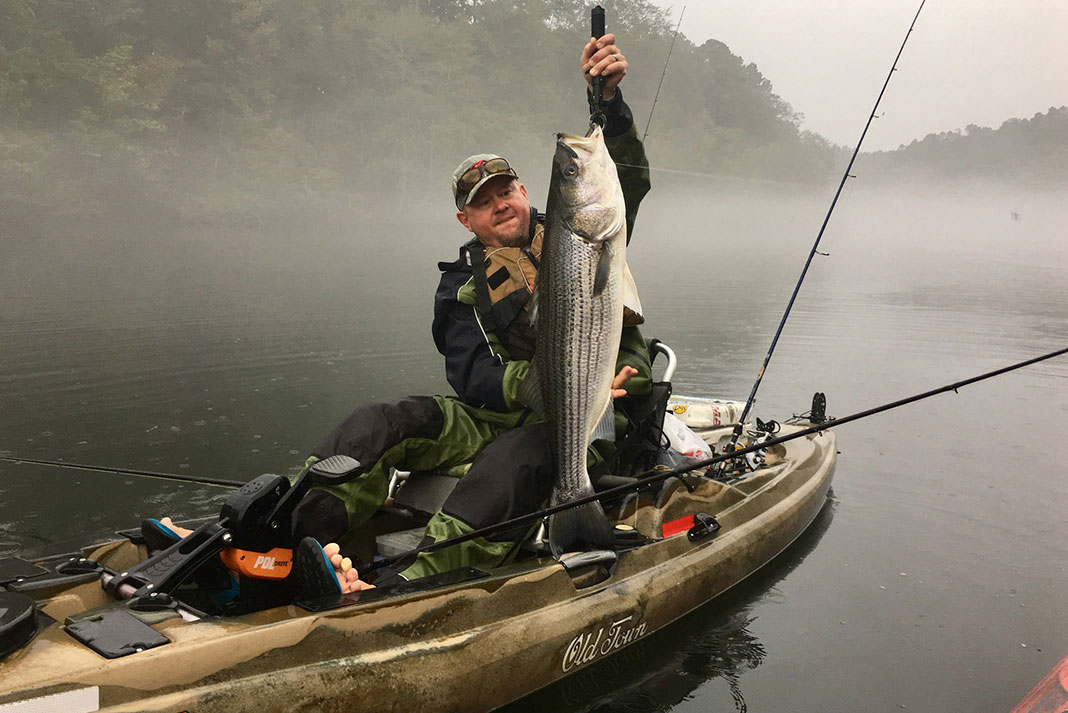Thirty-pound braid was evaporating off my spool at an alarming rate as a big striped bass towed my kayak. Before you picture the New England coast or Chesapeake Bay, I should tell you I was on Boone Lake in Tennessee.
Boone Lake, like many large lakes in America, is stocked with large striped bass. The transplants offer anglers a shot at a trophy striper miles from the fish’s coastal home water.
Catch Big Land-Locked Striped Bass Now!
Timing is the key. To make room for winter floods, Tennessee Valley Authority lowers the water level after Labor Day through late March. The drawdown concentrates bait and fish. Big striped bass are more active during the cooler months, so winter is prime time for trophy landlocked stripers.

To target large, landlocked striped bass, I head to the deep channels where the big, solitary fish do not have to compete for food with smaller striped bass. To further narrow the search, I look for steep shorelines where the big predators corral their prey.
The common belief is stripers only feed early and late in the day. But I’ve found large striped bass keep a different schedule. My most productive hours are between 1 p.m. and 4 p.m.
I know the fish frequent a specific area, so I persistently troll back and forth over a half-mile stretch for five to six hours searching for a strike.
Through trial and error, I developed a simple technique for trolling planer boards. I start with seven-foot, medium-heavy Shakespeare Ugly Stik Catfish rod. The rods have a lot of backbone and easily withstand the punishment from a slug striper.
For a reel, I use a Penn Squall 11 model 20LW with plenty of line capacity, strong level wind, a lever-activated free spool and a smooth star drag.
Thirty-pound Suffix 832 braid in low visibility green holds knots and is resilient and forgiving. I tie 22 feet of 20-pound Ande monofilament to the braid with a double-uni knot.
Then, I thread a small glass bead, a quarter-ounce worm lead and another glass bead to the end of my monofilament leader. I tie a 50-pound barrel swivel to the end of the leader with a Trilene knot.
To the other end of the barrel swivel, I add seven feet of 20-pound Seaguar Blue fluorocarbon with a Trilene knot. The business end of the rig is a 4/0 Owner Mutu Light Circle Hook and a live shiner. I’ve never missed a hook-up with this wicked hook; it twists and embeds itself firmly in the corner of the striper’s jaw.
To keep the baits separated while trolling, I use planer boards: a square plastic board attached to the line above the leader. The board floats on the surface at an angle that causes the force of the water to push the baits away from my kayak.
The planer board is attached to the line with a twist-on swivel and tension clip. When the fish strikes, the tension clip releases and the planer board slides on the line while I fight the fish.
To keep my rods elevated and pointing at a 45-degree angle, I use YakAttack Omega rod holders and LockNLoad track mount bases.
I run my planer boards about 20 yards behind the kayak. I slow troll just fast enough to keep the line tight and the baits swimming slowly. When I turn to troll back through the same area, I pull in my lines, turn the kayak and then redeploy the baits
Slow trolling live baits is the most popular tactic for landlocked striped bass. Pulling off the tactic in a kayak means keeping it simple and working one area until the fish respond.
James Shupe is a retired middle school principal who lives by the credo “work hard, play hard.” He has pursued big game around the world in freshwater and salt. James and his wife, Gail, feel blessed to live in northeast Tennessee.
Hours of slow trolling pays off with a lunker. | Feature photo: Jim Shupe









